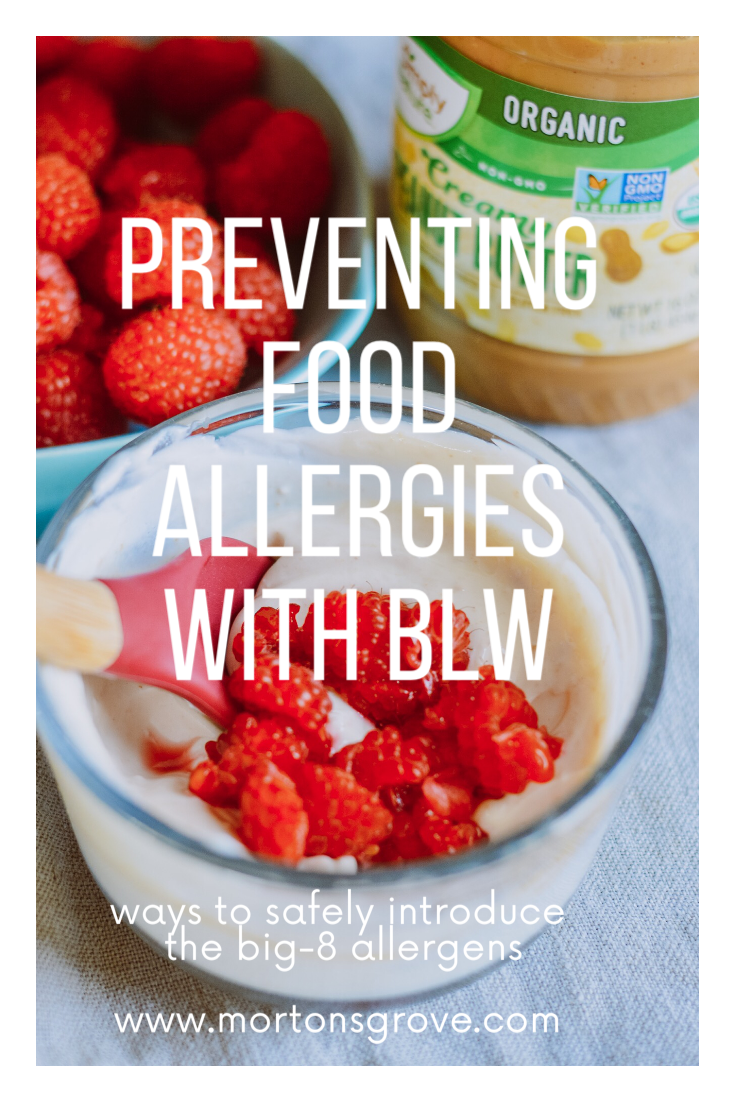Preventing food allergies with early introduction
When I work with families getting ready to start solids, there are a few things I can hardly wait to cover: introducing allergens is one of those areas. There is something so empowering about having the ability to potentially prevent food allergies by introducing those foods early. There is also something a little intimidating about it so I’m never surprised when a parent seems hesitant about this process.
If you’ve read this post on introducing peanuts, you already know that the old recommendation to hold off on offering potentially allergenic foods such as peanuts has changed. Thanks to the groundbreaking LEAP and LEAP-to studies, the recommendation is now to introduce peanuts and early (around 6 months) and often (2-3 times per week). Though the LEAP studies only studied peanut allergy prevention, the AAP recommends early introduction of all 8 major allergens.
“Tolerance to food allergens appears to be driven by regular, early exposure to these proteins during a ‘critical early window’ of development.”
This makes things way simpler than the recommended “schedule” that some of you might remember where certain foods were introduced at 9 months, others at one year, some at two years, and some foods not until three!
There are 8 foods responsible for the majority of all food allergies in kids:
peanuts
treenuts
soy
eggs
fish
shellfish
wheat
dairy
Current guidelines recommend introducing these foods early: as soon as you begin introducing solids, and including them often: a few times a week. Fill out the form below for a free allergen checklist!
A few things about allergies and intolerances:
Allergy: Abnormal response to food protein involving the immune system. Symptoms might include wheezing, hives, swelling, eczema, recurrent ear infections, red cheeks or red ring around mouth, and sometimes gastrointestinal response such as vomiting, diarrhea, gas, or bloating. Allergy symptoms usually appear within a few minutes to a few hours after eating. There is a test available to determine the presence of an allergy (called an IgE test). Your babe’s pediatrician might refer you to an allergist if this test is needed.
Intolerance or sensitivity: Abnormal response to a food or food additive that does not involve the immune system. Symptoms can be similar to allergy although more often take place in the digestive system. Symptoms often take longer to appear (for example, you might suspect a response days after allergenic food exposure) and may be milder and harder to recognize. There are several tests available to determine food intolerance or sensitivity, but the most widely accepted way to determine an intolerance or sensitivity is by doing an elimination diet with the help of the pediatrician and pediatric registered dietitian.
When I’m working with families and we cover the allergens and when to introduce, the next question is usually “OK sounds good….how?” So I’ve compiled a handy dandy list of introduction ideas for the top 8 allergens. Scroll up to snag that checklist as you go through the intro of all 8 allergens.
A few tips before we get into the how:
Once your babe has tolerated several foods, you can begin to offer foods from the list of allergens at any time. I recommend introducing allergenic foods one at a time along side foods babe has already tolerated. For example, if you’re introducing peanut butter first, wait a day or so to introduce wheat. This could make it easier to identify an allergic response.
You can introduce allergens in any order you like.
Baby is considered high risk for developing peanut allergy if they have a confirmed egg allergy and/or severe eczema (addendum from AAAAI). Talk with your pediatrician about introduction of peanut even earlier than 6 months if you think your baby might be considered high risk for peanut allergy.
Early introduction will not prevent all food allergies from developing. Some of the mechanisms behind allergy development are not fully understood and it is no ones’ fault if an allergy does develop!
Peanuts
Peanut powder sprinkled on avocado slices (make your own peanut powder by pulsing organic peanuts in the food processor until powdery)
1/2-1 teaspoon of creamy PB stirred into baby or regular oatmeal
Creamy peanut butter spread very thinly on toast
Marinate chicken thighs or legs in peanut sauce
For more on peanut introduction, head to this post!
Eggs
Scrambled until firm and sliced into strips
Hard boiled and sliced into strips or wedges
Stirred into oats until cooked thoroughly
Hardboiled and chopped or mashed with avocado
Wheat
Toast sliced into strips or halved
Muffin offered whole or slice in half (like this sweet potato muffin)
Pancakes sliced into strips or offered whole (this is a great one!)
Creamy wheat hot cereal
Soy
Tofu scrambled in a skillet with soft sautéed veggies
Edamame blended into homemade hummus
Soy milk stirred into oatmeal or baby cereal
Dairy
Avoid offering cows milk to drink before 12 months, it can displace nutrients from breast milk or formula and contains too much protein and not enough iron. Cows milk may be used in recipes or offered as whole milk yogurt or cheese (in these forms, it does not risk displacing breast milk or formula, and will not interfere as much with iron absorption). For more on introducing cow’s milk, see this post.
Plain, whole-milk greek yogurt offered on a spoon or right on the tray/plate
Shredded cheese
Pancakes with milk in the batter (like this recipe for fluffy quinoa pancakes)
Milk stirred into oatmeal
Cheese melted and stirred into black beans
Tree Nuts
Add almond flour to pancakes, cookies, or bars
Thinly spread creamy cashew butter on a rice cake or toast
Fish & Shellfish
Make “fish sticks” by slicing fish into sticks before pan frying or baking
Try sardines, flaked and bones removed
Mix flaked salmon with full fat greek yogurt and a squeeze of lemon (add some fresh chopped herbs)
Saute shrimp with the tail on, slice in half and serve
Sesame
Though not technically part of the “big 8” allergens, sesame is becoming a common allergen in North America. Hummus is a nutrient packed, smooth textured way to introduce this seed thanks to tahini. You can also stir tahini into purees, oatmeal, or on toast (tahini is crushed sesame seed paste, you can find it at most grocery stores).
For more information on introducing allergens and tons of recipes including all 8 major allergens, check out my new book: The BLW Baby Food Cookbook (available on amazon now!).
1. Prescott SL, Smith P, Tang M, et al. The importance of early complementary feeding in the development of oral tolerance: concerns and controversies. Pediatr Allergy Immunol. 2008;19(5):375-380.











